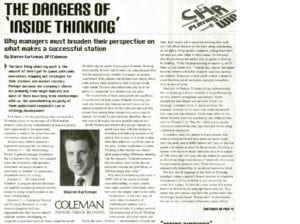This week, we continue with part 2 of a blog series that revisits a column I wrote for Radio & Records in 1999 found while digging through the Coleman Insights archives.

Despite significant changes in the industry over the past 18 years, I’ve been struck by how little some things have changed. I discussed four scenarios in which radio managers fail to get the full benefit of conducting research on their stations. This week, we’ll put the spotlight on:
Scenario 2 – We Have Great Numbers: A program director dismisses any need for conducting research on her station by citing its performance in the latest Nielsen book.
There is no question that Nielsen represents “the bottom line.” I worked for Arbitron, which was acquired by Nielsen in 2013, for six years and experienced how significantly the company’s data impacted radio stations first hand. This experience—and my contact with the company since I left there in 1993—taught me a great deal about the quality of the information they provide, even if there is always room to improve it.
Using Nielsen to assess how your station is doing, however, is not a very good use of their data. In fact, it is downright dangerous. Listener appetites and the competitive landscape can change so quickly that what Nielsen reported in the fall book might have little bearing on the winter results. It’s also been my experience that ratings performance and the strength of your position are not perfectly correlated.
Let’s play out a hypothetical situation. Let’s say you’re in charge of an Adult Contemporary station, currently number one in your target demo. When it comes to music, you’ve got a lot of room to play with and your playlist covers various segments of the format spanning four decades. Your morning show gets decent numbers, but at-work listening is where your station really shines. With things going so well, it would be easy to say, “Why do research”?
There are a couple of things that tend to remain constant in radio. First, you probably won’t stay on top forever. Second, if you are at or near the top, a competitor will likely try to slice into your success. What if you knew, with a great deal of clarity, where your own strengths and weaknesses lie? What if you knew the strengths and weaknesses of other stations in the market? What if you knew if the musical tastes of the market were changing? What if you knew that the awareness level and appeal of your morning show wasn’t as high as you expected? What if you discovered the broad nature of your playlist made you vulnerable to a more focused attack?
Would you rather have answers to these questions before your radio station is attacked?
A perceptual study—at Coleman Insights, it’s called a Plan DeveloperSM—can help shore up your fort before it is too late to discover your vulnerabilities. Perceptual research can also discover what your brand stands for in the marketplace. Stations with strong brands are far more equipped to withstand ratings wobbles than those without. Focusing on the next ratings book is a short-term strategy. Focusing on research that builds your brand is a long-term approach built for long-term success.
What kind of research should you do and is it giving you the results you need? Furthermore, are the results being interpreted properly as part of a larger brand strategy? Next week, we’ll focus on Scenario 3 – Confusing Tactical and Strategic Research.
